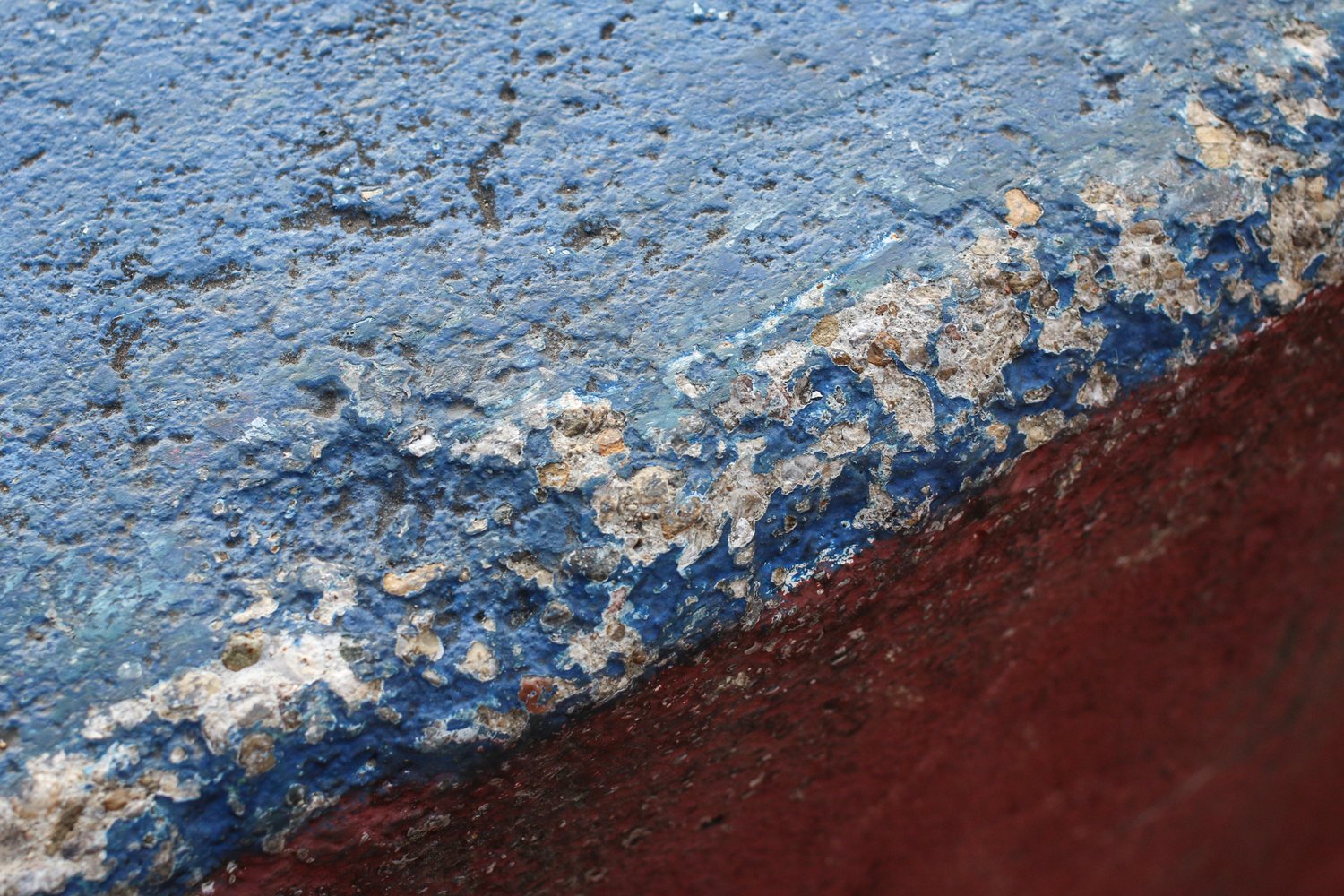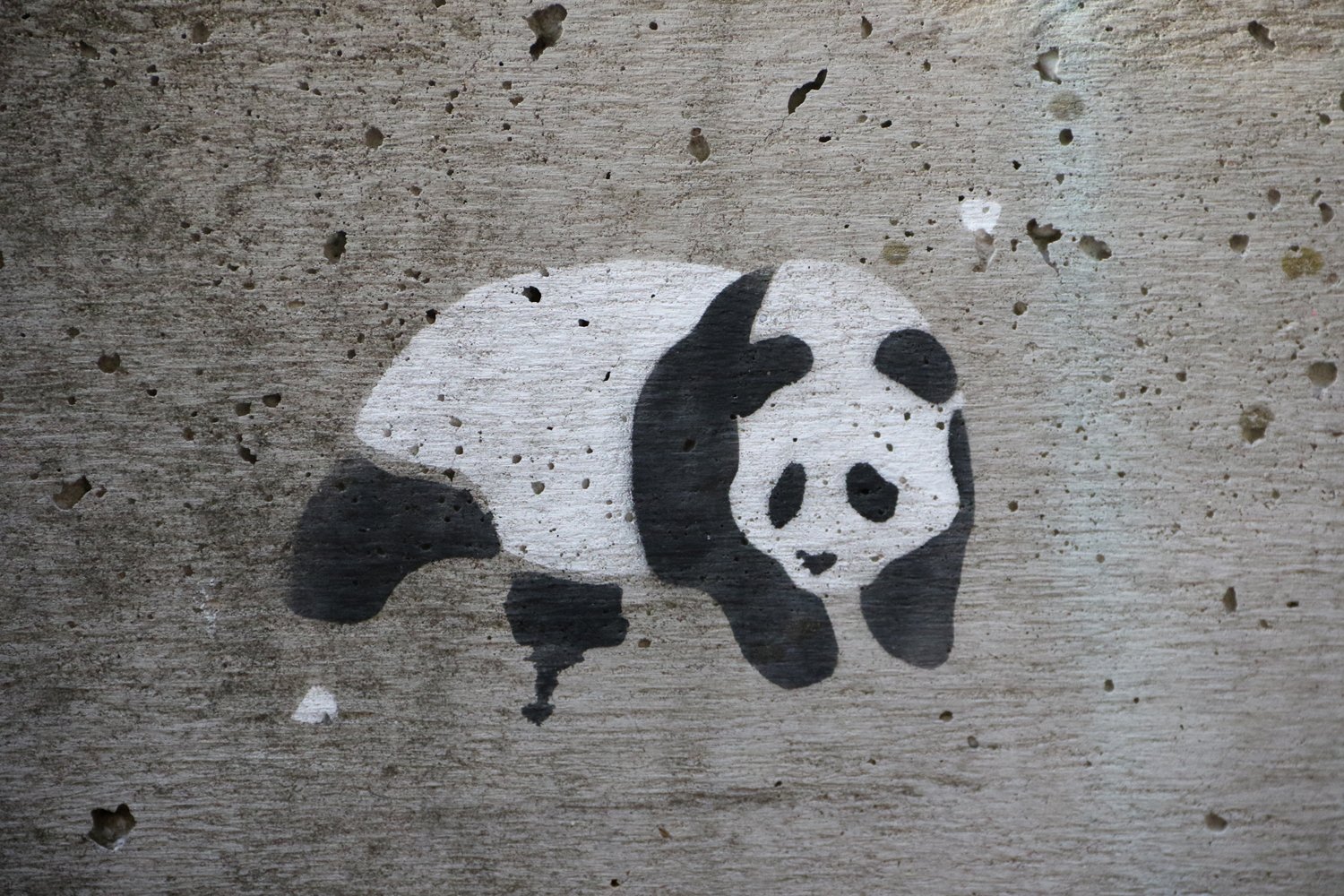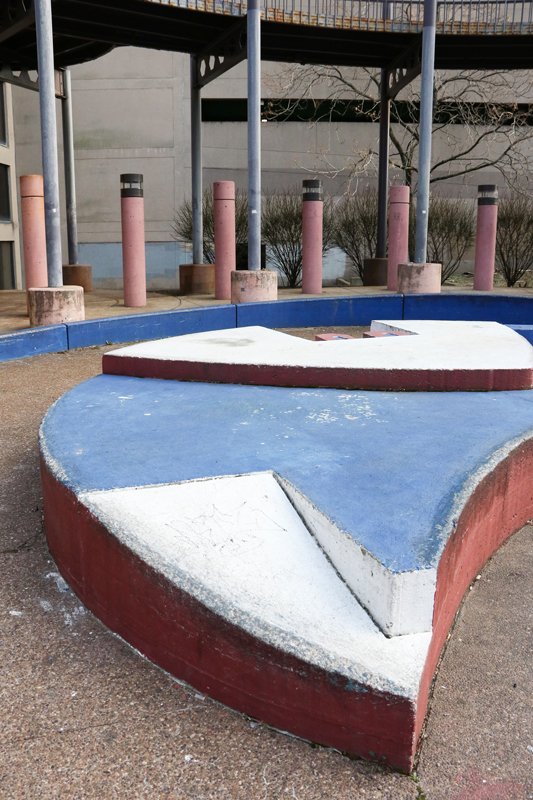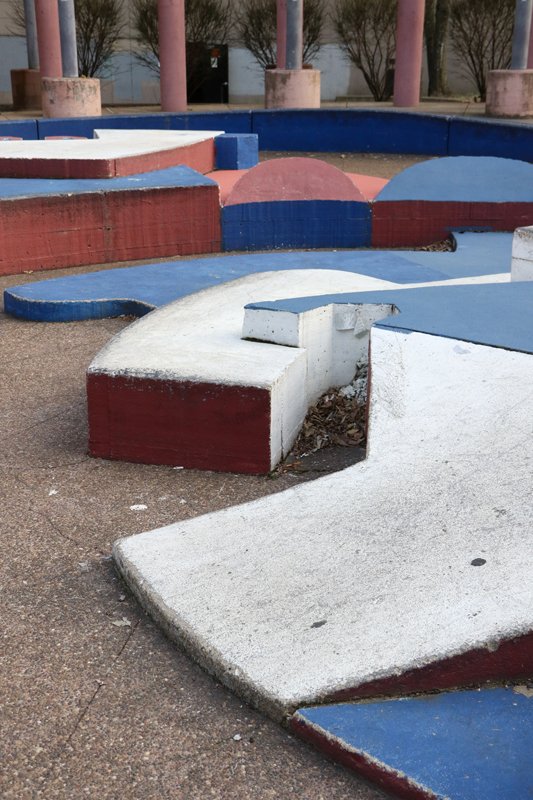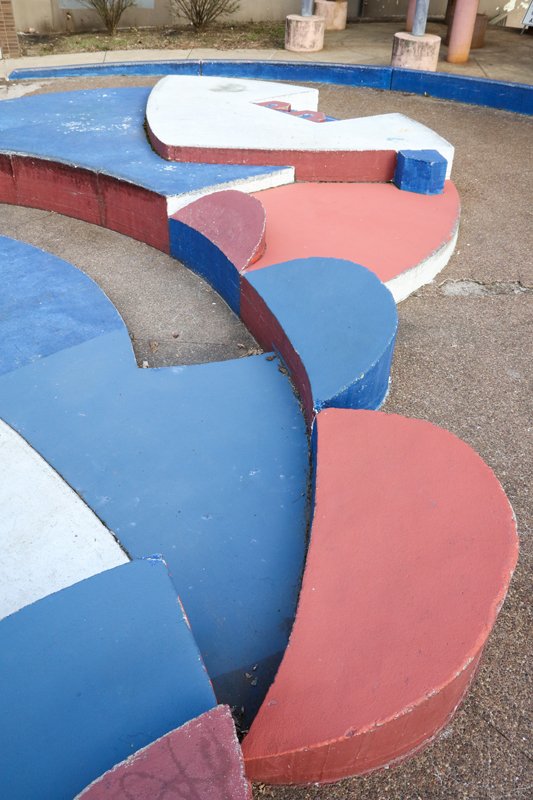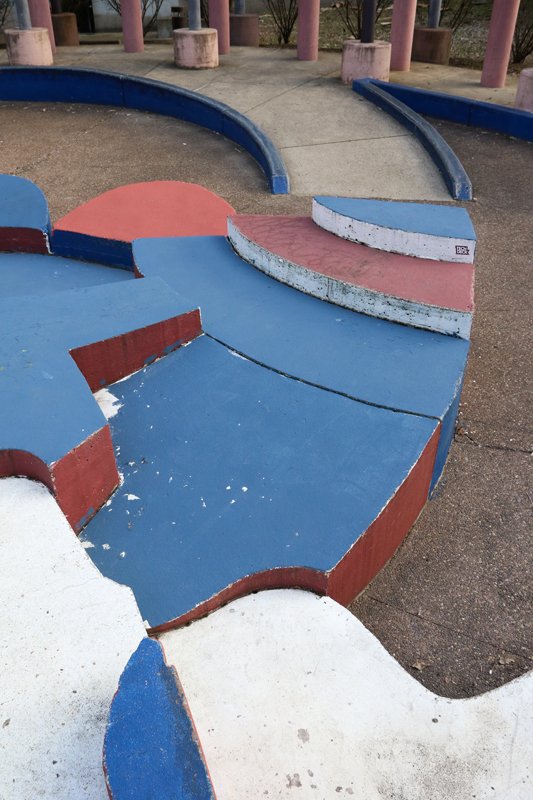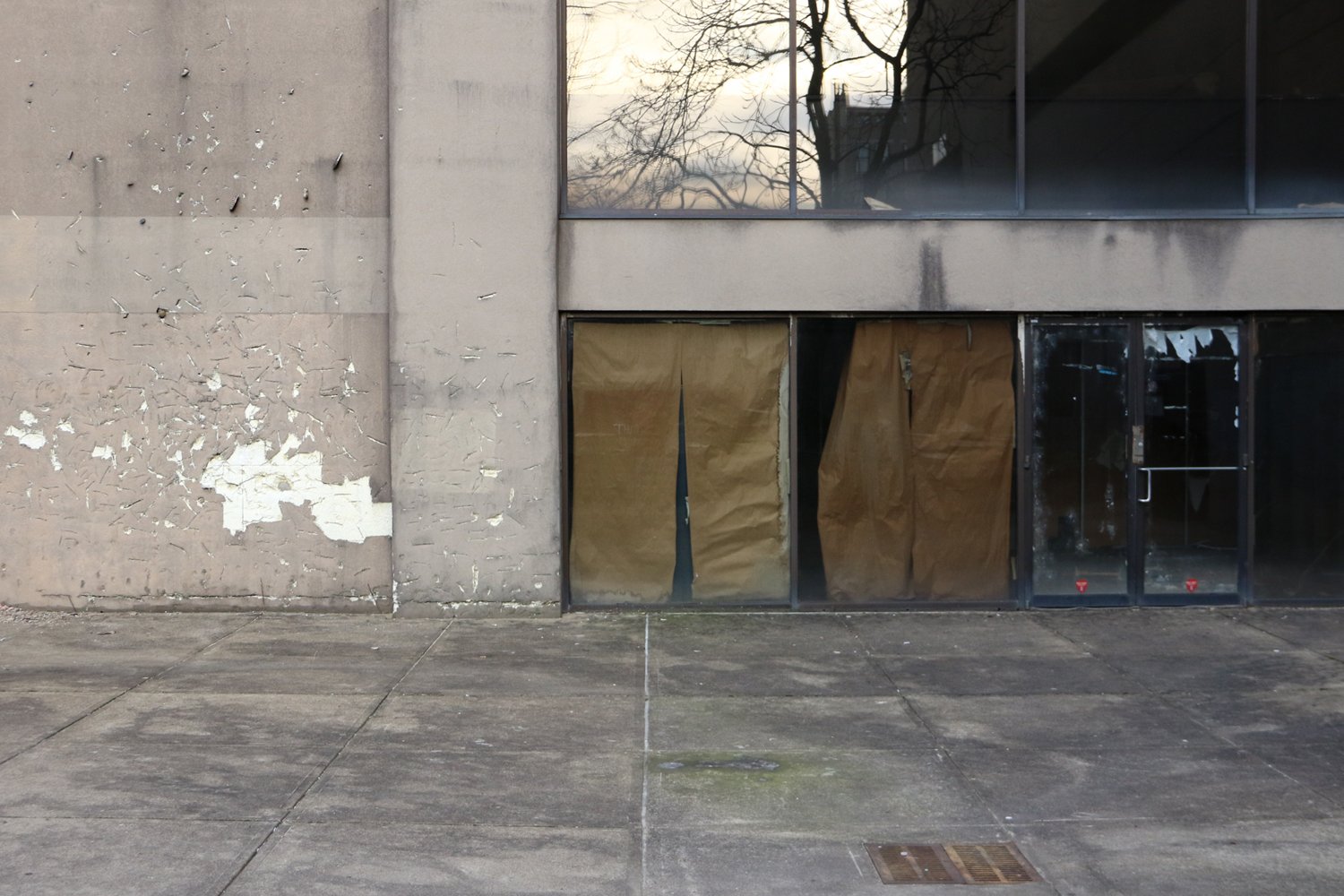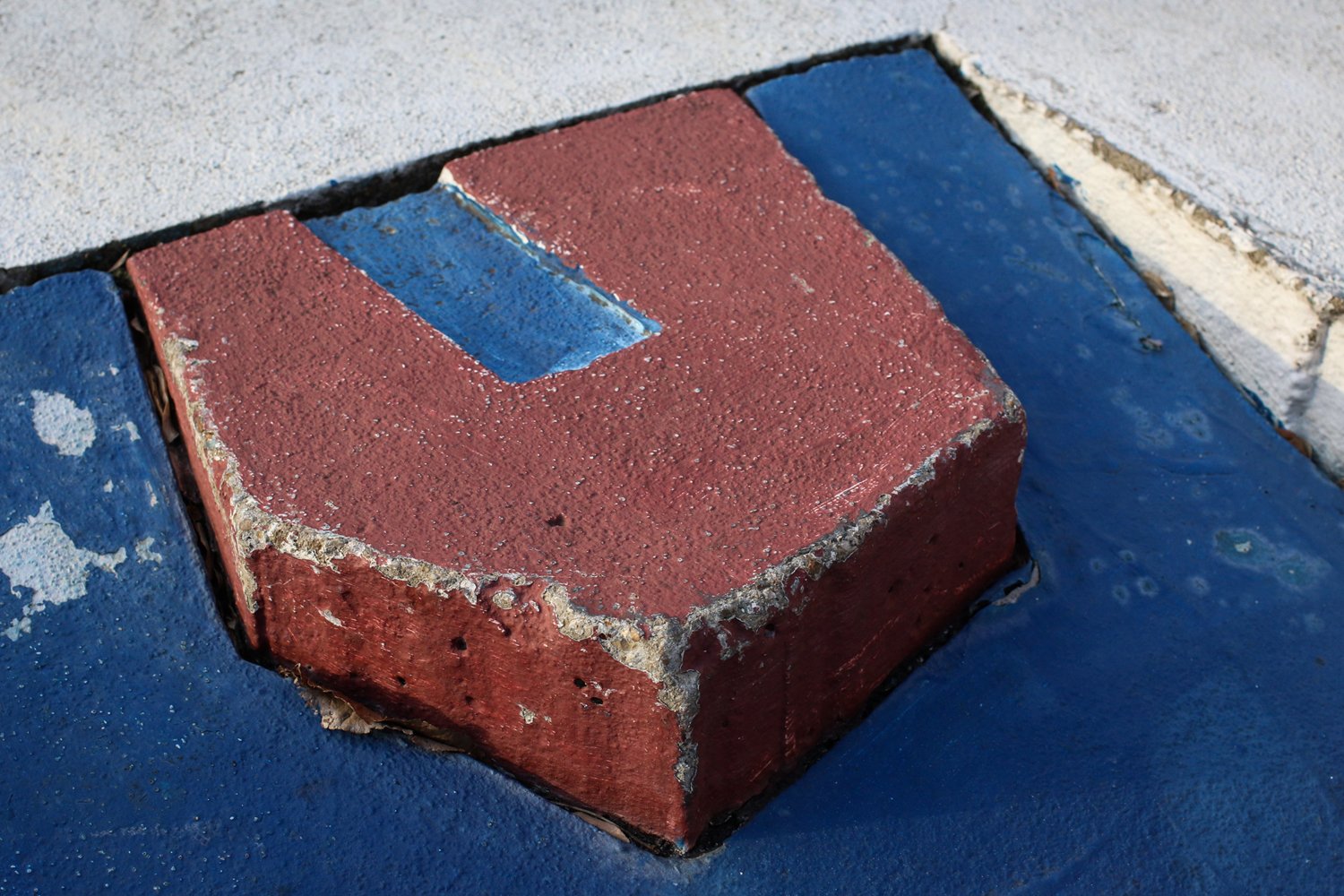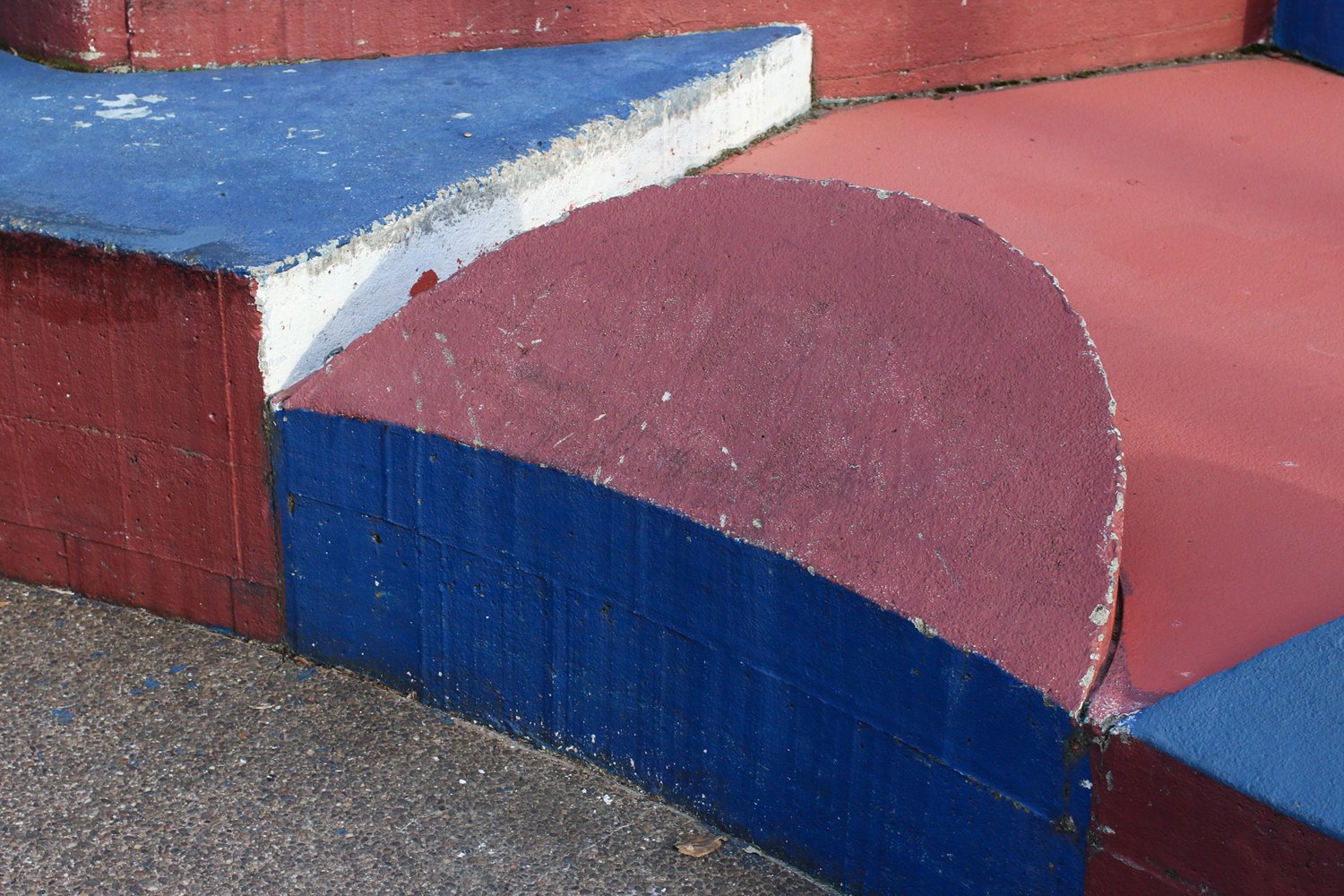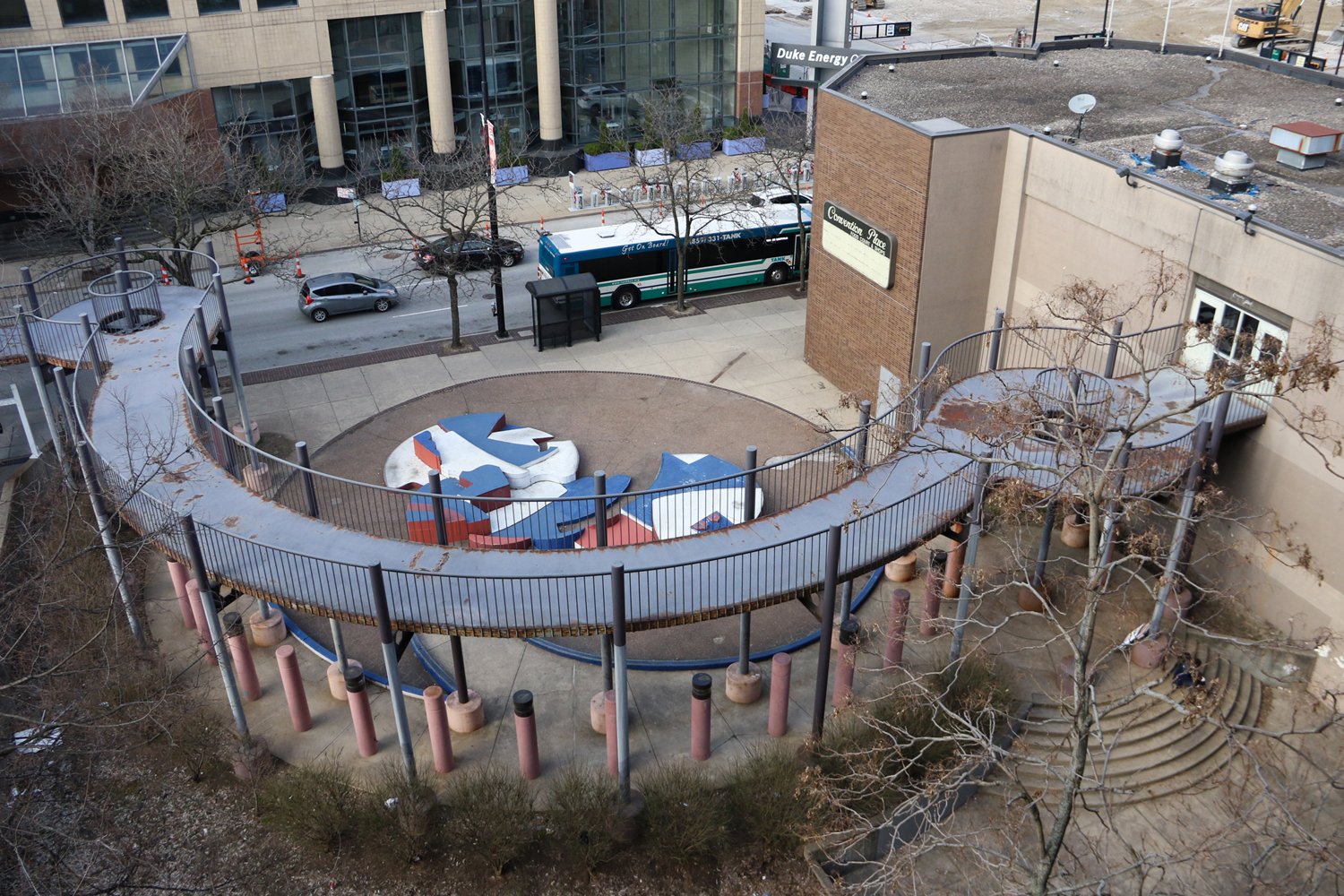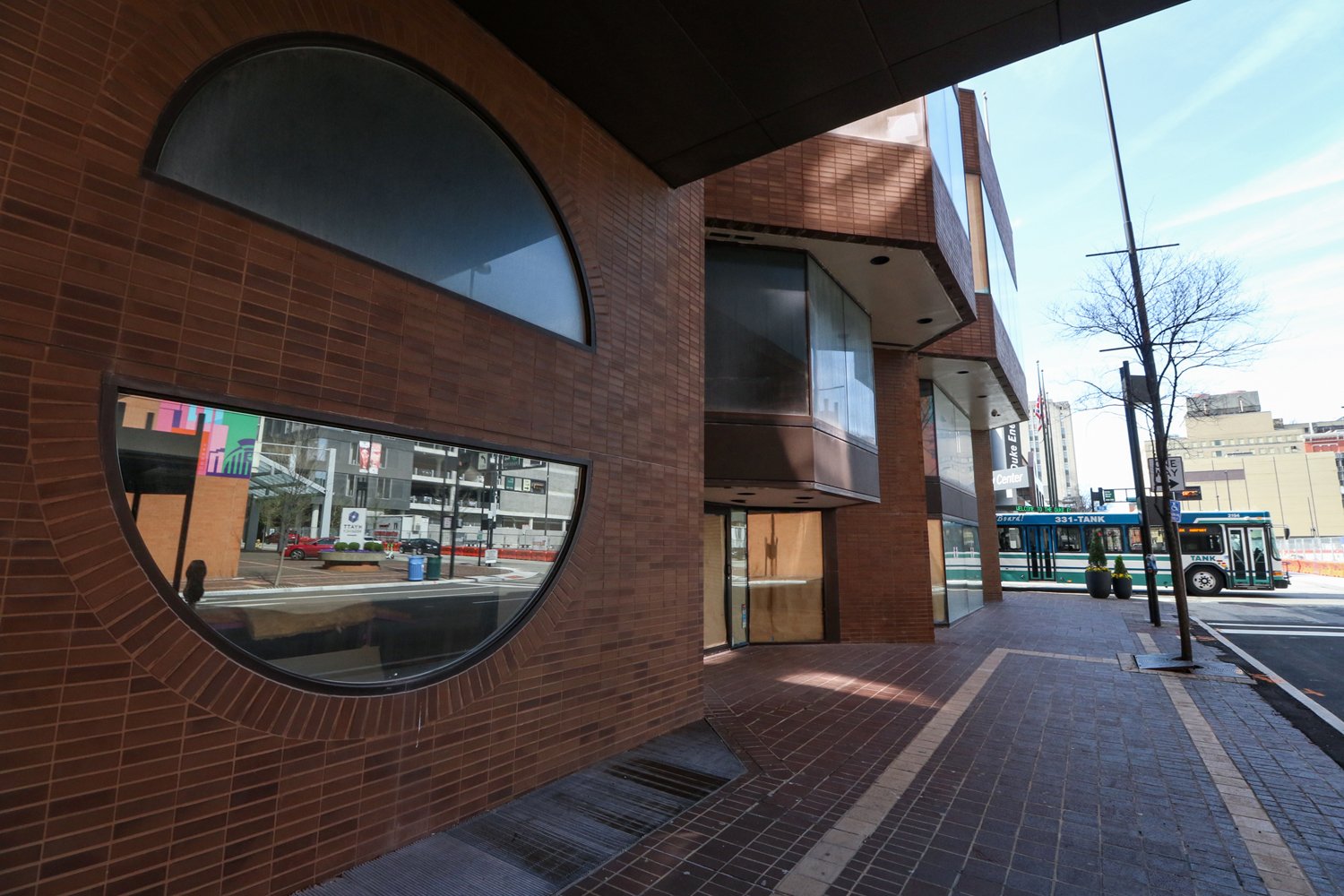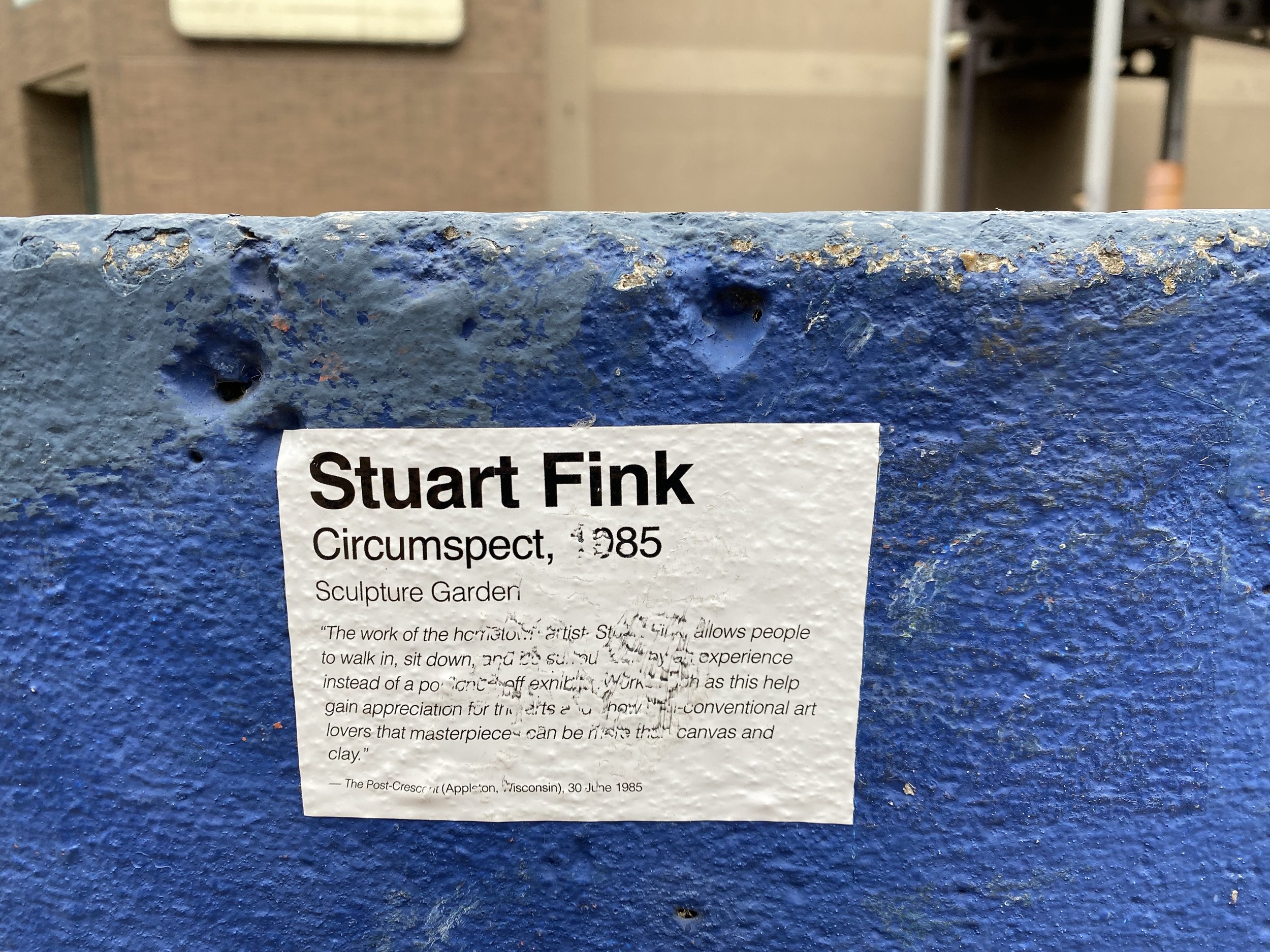Discovering Stuart Fink Through “Circumspect”
My paths stay pretty consistent: the way I bike to work, the blocks my dog likes to explore, the routes I prefer to jog. Even when I’m trying to chuck routine or out wandering on various schemes—this city has begun to feel so small. The core of it that is. What bureaucracy refers to as the “Central Business District,” but most just call “downtown.” No matter how present or free of distraction I try to be—there are times when I can’t help but feel as if I’ve experienced this neighborhood—its characteristics and its corners—thousands of times. For awhile, I only worked down here. Now I live here. It didn’t take long for the excitement of residing in downtown Cincinnati to wear off. For it all to become my usual, unremarkable normal. Just a world I exist within. Every now and then, though, I’ll come across something that stops me. Some detail or overlooked element that commands my immediate attention.
“Shapes Park” as seen in March 2022.
It was one of those typical Midwestern days. The kind where the calendar says fall, but the humidity implies: “you’re in Hell (or Florida).” Hands on my knees only halfway through a three mile run and struggling to catch my breath along West Fifth St., I looked up to see a collection of abstract concrete structures. I’d seen this place many times before, but I’d never really seen it. Now, I was being drawn in, walking all over it and inspecting what Google Maps simply referred to as “Shapes Park.”
Whatever knowledge of Art History I once possessed faded years ago with the conclusion of an introductory college course. So, to describe this place in a stylistic sense…cubist? Maybe? The figures are seemingly random, rising out of the ground and flowing into each other at various points. There’s a few hard edges, but most of the structure is rounded and curved. Although its shades of red, white, and blue are well faded, it’s still a colorful contrast to the dull surroundings of an aging parking garage and rusting, pastel pink lamposts. At first glance, one might think it’s a skatepark—but even with my short-lived, accident prone interest in the sport—I knew this wasn’t a purpose built facility for imitating Hawk or Burnquist. Nevertheless, the remnants of wax and chipped paint on the concrete provided evidence of its use for the activity.
Stencil bearing the logo of the Enjoi skateboard company located on the structure.
The fact that this kind of random structure exists in Cincinnati didn’t surprise me. It seemed like an atypical vestige of another era, the 1980s if I had to guess, fitting for its immediate environs. On the quiet end of downtown, it also wasn’t unusual that this structure hadn’t really been maintained. That just made it all the more appealing, though, and I had to know: “what the hell is ‘Shapes Park,’” and, “why is it here?” I made a note, finished my run, and figured I’d get around to answering that question one day.
In a bout of insomnia a few months later, I illuminated my bedroom office with the glow of computer monitors and dove into the mystery as an excuse for not dealing with more pressing matters. Via a friend (shout out to Nick Swartsell), I’d learned that the “park” was actually an art installation called “Circumspect.” Newspaper archives credited it as the work of local artist Stuart Fink. If anyone could tell the story of this place, he’d be the one.
“Stuart Joseph Fink, 83, passed away on December 1, 2021 at his home in Cincinnati, Ohio.”
Those were the words of a local funeral home, published about three weeks before I stared into the blue light of the internet while trying to track Fink down. “Stuart’s artwork was his life.”
• • •
Whether it was the urban renewal policies of the mid-20th Century; the shopping mall craze of the 70s and 80s; or the proliferation of bars, “dining concepts,” and condos we see today: the term “renaissance” gets thrown around a lot when it comes to discussing matters of civic development. Those with a proper understanding of city planning could probably better predict if this current whirlwind of renewal is the one that will stick—a true, long term, sustainable plan for the city’s future—but history has shown that Cincinnati has acquired mixed results when it comes to downtown revitalization projects. In the mid 1980s, local officials were focusing that era’s rejuvenation heavily on the local Convention Center and its surroundings.
Convention Place office tower along downtown Cincinnati’s Elm St.
In a February 1985 edition of the Cincinnati Enquirer, contributor Jayne Merkel lauded the then-new Convention Place mall and office tower as a “prize meeting of designs, structures, purposes.” Depending on your age, and if you’re from here, you may or may not remember this particular urban mall that used to sit at the corner of Fifth and Elm on the western edge of downtown. You’d be forgiven if you confused it with the other, nearby (also now gone) mall known as Tower Place. Along with the city’s Skywalk system (itself now a shell of its original vision), these types of developments were a shortsighted attempt at competing with the burbs. “As in a suburban shopping mall, downtown’s new Convention Place includes a food court,” triumphantly states a photo caption in that same Enquirer story.
Former Convention Place marquee.
Skywalk map outside of an entrance to Convention Place. Covered here back in 2008/2020, the Skywalk never quite realized the full vision set out for it.
The article by the paper’s architecture critic goes on to praise the development for the way it’s “connected to the cityscape” via automobile access, Skywalk bridges, and street level retail. “Toronto style,” apparently. Convention Place itself only came about because the city had agreed to build an 800 car parking garage in order to entice the development of a Hyatt Regency hotel. Although the notion of a mall within the city center is outdated by contemporary standards, the concept was in vogue at the time. One could even argue that Convention Place’s specific design was somewhat progressive for the moment. The city could’ve just built a hollow parking structure, but instead attempted to do more. While newspaper archives (and longtime downtown office worker veterans) fondly remember the facility’s indoor food court and interior shops, Convention Place did differ from similar structures both within Cincinnati and in other cities. Credit where it’s due: the addition of street facing retail kept it from being a walled-off, exclusive commerce center separate from the surrounding urban environment. That doesn’t really make up for the original sin of demolishing the historic structures that were there before, but at least someone tried to build more than just a parking garage.
The nearby Hyatt Regency as seen from the top floor of the 217 W 5th St. Garage, the parking structure constructed by the City of Cincinnati to lure the hotel.
Ground level entrance to Convention Place where it meets “Shapes Park,” as well as, the 217 W 5th St. Garage.
Pedestrian entrance to the 217 W 5th St. Garage from the back of “Shapes Park.” The garage is dimly lit with aging elevators, but still popular with commuting office workers.
Sitting only a few stories tall and connected to the nearby Hyatt and Convention Center via Skywalk, the idea was that this development would simply be the base of further development. Another hotel (or an expansion of the Hyatt) could be built both on top of Convention Place and directly next to it. Referred to as “Block D West,” the empty space on Fifth Street between the new mall and parking garage entrance ramps would serve as any future expansion’s ground floor lobby. The Hyatt Regency would have an exclusive option on the site until 1991, but having just opened in 1984, there were no firm plans just yet. So, the city sought to do something productive with Block D West in the meantime. Rather than leave the space empty, they reached out to a local artist.
“Sculptor Stuart Fink resembles closely the classic starving-artist stereotype,” quipped The Cincinnati Enquirer in a 1979 profile of local creatives. In one brief paragraph, Fink is described as having two part-time jobs (“washing dishes and teaching a night class at [the University of Cincinnati]”) that allowed him the flexibility to focus on his art. Characterized as “serene in the face of sacrifice,” it’s also noted that one of his original works can sell for up to $3500 (about $13,860 in 2022). Fink’s renown wasn’t limited solely to the Cincinnati art scene, however. It was a work of his from another town that got Queen City officials interested in having him fill the void on West Fifth.
According to a February 1985 story in Cincinnati Magazine, Fink had offered the city of Cincinnati one of his existing works. That particular piece, done as a study for a larger work at the Columbus, Ohio airport, intrigued Cincy’s Urban Design Review Board so much that they opted to commission him for something totally original. Credited as having a budget of $35,000 and a year of planning, Fink set out to deliver the city its first “sculpture park.” He would tell the publication: “I wanted it to be more of a place than a thing.”
Downtown Cincinnati’s sculpture park: commonly referred to as “Shapes Park,” but officially known as “Circumspect.”
Later that year, an art critic touring Cincinnati and writing for The Post-Crescent of Appleton, Wisconsin would laud the sculpture park this way:
“The work of the hometown artist, Stuart Fink, allows people to walk in, sit down, and be surrounded by an experience instead of a portioned-off exhibit…Works such as this help gain appreciation for the arts and show non-conventional art lovers that masterpieces can be more than canvas and clay.”
• • •
Although made from concrete, Circumspect was always meant to be ephemeral. In theory, its days were numbered from its 1985 debut—simply a placeholder until future development flourished around the Convention Center. 37 years on, however, the Hyatt never expanded and any other proposed ideas never came to fruition. Stuart’s sculpture park became a lasting, yet enigmatic fixture.
Circumspect as seen in March 2022.
This massive surface parking lot takes up half a block and sits immediately adjacent to Circumspect, as well as, the parking garage constructed to initially lure the Hyatt.
Occasional circumstances bring it some love and attention—the piece had a bright, rainbow-like color scheme in the early 2010s and then received a fresh coat of patriotic colors when the 2015 Major League Baseball All-Star Game came to town, but the paint’s fading once again. Trash and debris blow about in the wind, settling in clumps against the stoic parking garage. And what was meant to be a temporary, open-air Skywalk bridge between the mall and Convention Center now stands rusting and closed off above the sculpture park.
The nearby Hyatt as seen from below Circumspect’s “temporary,” open-air Skywalk bridge.
The Hyatt’s still around, listed as a “4-star” hotel on Google and carrying solid reviews, but Convention Place is long gone. At least on the inside. The physical structure still stands, but tenants dwindled amid battles over foreclosure, deferred maintenance, and tax delinquencies lasting several years. The City of Cincinnati eventually got involved. So did the FBI.
The shuttered Convention Place complex as seen at street level.
After the City took over the Convention Place property and began seeking out redevelopment plans, a federal sting led to the arrests of City Council members Jeff Pastor and P.G. Sittenfeld on alleged corruption in relation to the site’s redevelopment. Pastor’s case is still ongoing, but in July 2022, Sittenfeld was found guilty on counts of bribery and extortion. Although Convention Place is now slated for demolition—it’s still standing as I write this.
So is Circumspect.
On a Spring afternoon, the only beings here are a bus driver taking a smoke break, chirping birds, and myself as I finish writing this story. The traffic on West Fifth is loud and obnoxious, but if you can take the time to focus and wander around Circumspect as I did just a few moments ago—you can still find some peace in this sculpture park. Even for a cynic like myself, it still inspires curiosity and invites interaction.
Sitting here, looking over Fink’s work flanked by the convention center, baking in the sun, and speckled with weeds and cracks in the concrete—I wonder what will happen to it when the nearby Convention Place finally meets the wrecking ball. Maybe it’s too expensive to remove, its physical structure too cumbersome to dig up and crush. Maybe, whoever’s in charge, has no idea what it is or that it’s even here. A fresh coat of paint, a few new lightbulbs, and the cops to keep assuming it’s a skatepark—cruising on by and ignoring folks as they try to kick flip—is really all it needs. Located in a nine-to-five, relatively quiet, and pretty boring area that’s now being primed for yet another “renaissance” of sorts: there’s talk of more hotels, maybe a new arena, and a large-scale renovation of the convention center. But there doesn’t seem to be any specific mentions of what will happen to this artwork. There’s no mention of Fink, either. No plaque or even a token acknowledgement of his cultural contribution to this particular corner of downtown. His work survives him in galleries throughout the city, in pieces such as the Rose and Izzy Kadetz Fountain just a few blocks away, and in Circumspect itself. An irreverent detail of the city that’s still leading folks like me to Stuart’s story.
The Rose and Izzy Kadetz Fountain, designed by Stuart Fink, in nearby Piatt Park.
As Stuart aged and was faced with tremors brought on from a medical condition that prevented him from sculpting, he still found a way to create art. In a May 2016 feature in Sculpture Digest, Fink described how he was working with an art collector and factory owner who’d “translate” for him—the businessman using his mechanical resources to physically manufacture Fink’s dictated visions for artwork. “The minute I stop doing art, I’ll probably croak,” Fink told the magazine. “I’m not going to quit.”
Maybe I’m drawing too cliche a conclusion from Stuart’s quote in an effort to wrap up this story somewhat succinctly, but there’s some personal relevance to be found. Especially on the days when I travel the same old routes and go through the same old routines, the days when I become frustrated and bored with where I’m at in life, the city I live in, or the work I’m doing.
Thanks, Stuart.
For Circumspect, your contributions to this city, and for the reminder to not quit. To continue exploring small details, interesting things, and following where their stories lead.
• • •
Coda:
Per the Port of Greater Cincinnati Development Authority: it turns out that Circumspect is set to be removed in concert with the eventual demolition of Convention Place. Go see it before it’s gone and have a good thought for the late Stuart Fink while you’re there.
I went ahead and added some acknowledgment of Fink:
• • •
Update | December 12, 2022:
The wonderful @5chw4r7z snapped the below photo of Shapes Park. For now, the sculpture garden is still standing, but my stickers are starting to decay a bit:
Update | May 3, 2023:
Passed by on an evening run and it seems demolition is sadly imminent (stickers still there, though)::
Update | May 23, 2023:
Demolition began this morning:
Update | January 1, 2024:
“Circumspect” has been fully demolished while development work continues at the site.
A friend recently passed along a book about Stuart Fink and his artwork. Included in that publication are two photographs showing “Circumspect” in its original form:
Publication caption: “Sculpture Park, Cincinnati, Ohio | Concrete | 1989.”
Publication Caption: “Sculpture Park, Cincinnati, Ohio | Concrete, 30’ x 60’ | 1989.”
Additionally, The Art of Stuart Fink also features a photograph of the Columbus Airport work which preceded “Circumspect:.” Thanks to information provided by user DTCL11 on UrbanOhio.com, it appears as if that piece is sadly gone too.
Publication caption: “Port Columbus International Airport | Columbus, Ohio | Concrete | 1984”
Since 2007, the content of this website (and its former life as Queen City Discovery) has been a huge labor of love.
If you’ve enjoyed stories like The Ghost Ship, abandoned amusement parks, the Cincinnati Subway, Fading Ads, or others over the years—might you consider showing some support for future projects?




